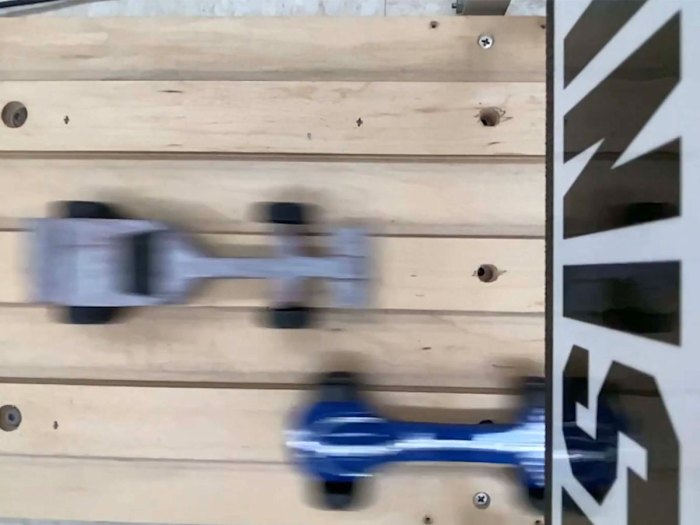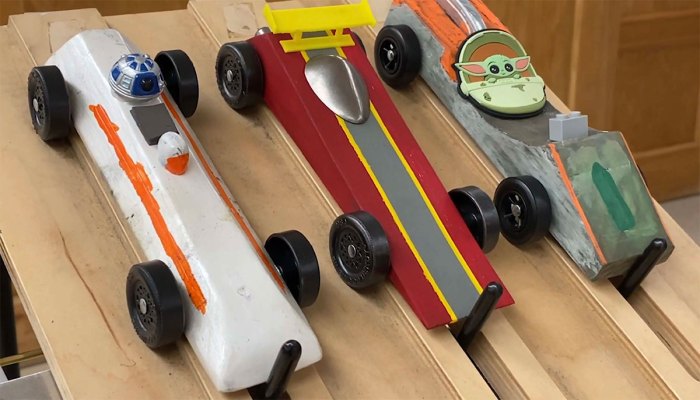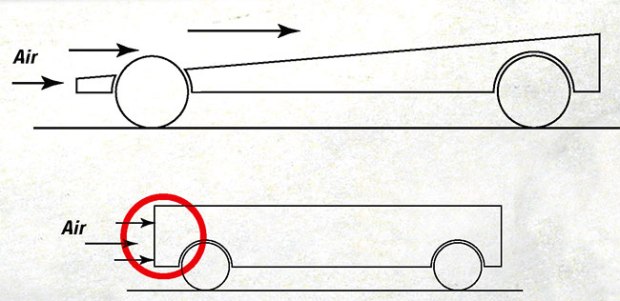How to Make a Fast Pinewood Derby Car

Packs nationwide are gearing up for their annual Pinewood Derby. There are a variety of ways to make your Pinewood Derby car go faster. Explore the following tips to optimize your car’s performance and gain a competitive edge in an upcoming race.
BASIC GUIDELINES FOR PINEWOOD DERBY CAR DESIGN
The possibilities are endless when it comes to picking a shape for your Pinewood Derby car. Before you begin, consider the following general guidelines:
Avoid Pointed Noses: A pointed nose will make it difficult for your Pinewood Derby car to rest on the pin at the starting gate. It may also cause your Pinewood Derby car to get bumped around when the pin drops, and it can create problems for electronic timing systems at the finish line.
Weight Distribution: Leave ample wood in the rear of the Pinewood Derby car so you can place additional weight there. Concentrate the majority of the weight in the rear for optimal performance.
Maximum Weight: Aim for the maximum allowable weight, typically limited to 5 ounces in most races. If your car falls short of this weight, strategically add coins or other weights to meet the requirement.
Clarity in Orientation: Clearly distinguish the front and back of your Pinewood Derby car. In many races, the race officials — not you — will actually place each Pinewood Derby car on the track. Sometimes the officials put the Pinewood Derby car on the track backward because they can’t tell which end is which.
Aerodynamic Design: Select a design that facilitates smooth airflow over and around the Pinewood Derby car body. Pinewood Derby cars with aerodynamic profiles go faster.
See photo galleries of hundreds of Pinewood Derby car designs.

10 STEPS FOR DESIGNING AND BUILDING YOUR PINEWOOD DERBY CAR
You don’t have to strive for the fastest Pinewood Derby car to have fun competing in your Pinewood Derby. But if you and a helpful adult are willing to put in the extra time and effort, these tips are for you.
1. Bake the Block: Start your Pinewood Derby car project by baking the wood block at 250 degrees for two hours. This removes moisture and lightens the block, allowing you to place more weight at the rear of the car where you actually want it.

2. Crafting the Design: Outline your Pinewood Derby car on paper, cut it out, and affix it to the wood block.
Remember, a rectangular car is not an aerodynamic design. The most basic aerodynamic design is a simple wedge. If you don’t have time to design a complex car, a wedge will work just fine.
Download a Pinewood Derby car template PDF to help you create your design.
3. Rough Cut the Design: Use a coping saw or enlist the help of a responsible adult with a power tool to cut out the rough shape of your Pinewood Derby car.
4. Shape Your Car: Smooth edges and shape your car using sandpaper. An adult can assist with a rotary tool or other shaping tools.
5. Sand and Paint Creatively: Reduce friction by smoothing the car’s surface and paint an awesome design to make it look great.
How to paint your Pinewood Derby car to give it a shiny finish.
6. Axles and Wheels Alignment: Make sure they are aligned perfectly straight. You can test the alignment of your axles by pushing your car across a smooth floor or table. It should roll smoothly in a straight line.
— Consider a Three-Wheeler: Raise one wheel about 1/16 inch higher so it never actually touches the track. Less friction = more speed. Rules vary from pack to pack, so make sure to check your pack’s Pinewood Derby rules to make sure three wheelers are allowed in your race.
— Extend the Wheelbase: Maximize the distance between front and rear wheels. Again, make sure this is allowed in your race.
Learn about polishing Pinewood Derby axles and wheels to reduce friction.
7. Secure Axles with Glue: Glue the axles firmly in their holes to ensure that they stay perfectly placed, but make sure you don’t get glue on your wheels.
8. Strategic Weight Addition: Remember to make your Pinewood Derby car as heavy as the rules allow. In general, it’s best to place weight to the rear of your car because a heavier rear increases speed.
Learn scientific Pinewood Derby speed tips from a former NASA engineer.
9. Use Graphite: Add graphite or another dry lubricant to reduce friction. The less friction between the body and wheel, the better.
10. Have fun! And finally, remember the most important rule of a Pinewood Derby is that it’s supposed to be fun. While you should always strive to do your best, don’t get caught up in winning or having the fastest car. Just enjoy the ride.
Adapted from the book “Pinewood Derby Speed Secrets,” DK Publishing, $12.95 softcover.
how do you make it go 759mph
how did you make it go 795 per hour
I know the answer to this one. Strap a GE jet engine to it. It will go 759 MPH.
wrong it will breeak the sound berrier and make you death
its all about axle alignment in the end, make a test track ( a piece of drywall works great) raise one end with a 4×4, ensure your car rolls straight and true.
I think its about axels and weight. we had our weight in the front then we put it in the back and won by alot more.
i used this tips and won 100 races in a row
I used the speed secrets last year on my sons car and he won first place in his den, first place over all and first place at the district race. I also wanted to let evcery one know that attention to detail is what wins the race. we did a test with 3 cars without graphite and with graphite, with graphite all three cars picked up 1/10 of a second in time. Graphite makes the differance.
Good luck to all racers and have fun.
how do you add graphite to a car this is my first one
already have speed secrets i am getting design book
A person told me awhile ago if you want to win speed then go with a wedge and get it as close to the weight requirement as possible. That was the best advice ever. All the other ideas are tweaks but, if you put together a boring old wedge you will be top 3 at least, with pretty much no axel polishing, straightening etc. Another great tip for weigh in is thumb tacks. Easy to place and move off or on. The cars right at the weight do the best everytime.
This will depend on how competitive your Pack is. My Pack dads are engineers and builders. If you don’t polish axles, you won’t be a speed contender. Then again, we give certificates for good looking cars, goofy looking cars, and the most obviously boy-made car. It’s about fun.
i cant find stickers
Hobby Lobby and Michaels have the stickers
My son just won for the 2nd year in a row. Kept axle space the same per local rules. used tungsten weights which are much heavier and also used a COG kit to balance the car. We made a Batmobile and even put red LED lights in the front. We also won the most orginal design trophy
Last year I went for looks with a sweet looking 1933 Ford Coupe design;AND WON FIRST PLACE!!!!! This year is my first to go for speed points, and my Dad recommended these tips to me.
Axels are not to be moved from the origional markings. And 3 legged cars are not allowed in our rules.
We had a scientist dad in our Pack whose son is now in Boy Scouts that built their own track at home, and made hundreds of minute changes to their car to develop a very fast car. They did this every year and won every race in the Pack and District. The book is simplistic compared to this guy’s secrets. I just wish he had written a book. But if you’re not in an overly competitive pack with alot of kids, it’s great.
Encourage the parents who win EVERY year to leave some room for everyone else. My son won 2 years in a row. The third year we made a fun, goofy car that was fast enough for him to win a few heats, but not enough to win overall. Its good to let everyone have a taste of victory.